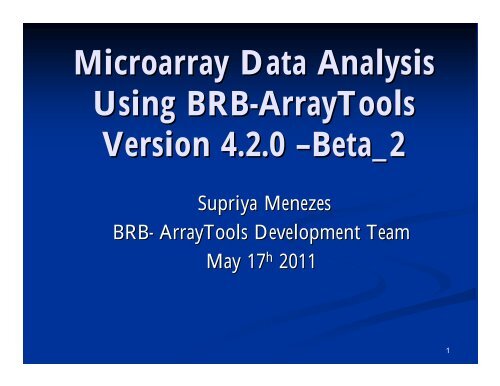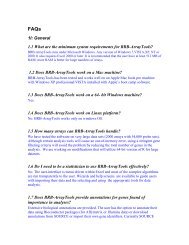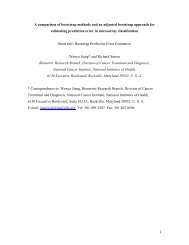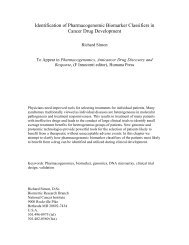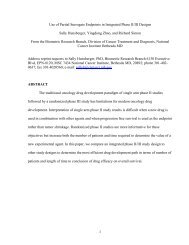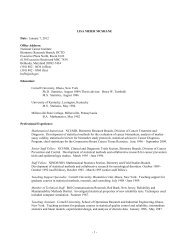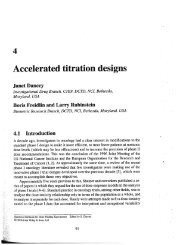Microarray Data Analysis Using BRB-ArrayTools Version 4.2.0 ...
Microarray Data Analysis Using BRB-ArrayTools Version 4.2.0 ...
Microarray Data Analysis Using BRB-ArrayTools Version 4.2.0 ...
Create successful ePaper yourself
Turn your PDF publications into a flip-book with our unique Google optimized e-Paper software.
<strong>Microarray</strong> <strong>Data</strong> <strong>Analysis</strong><strong>Using</strong> <strong>BRB</strong>-<strong>ArrayTools</strong><strong>Version</strong> <strong>4.2.0</strong> –Beta_2Supriya Menezes<strong>BRB</strong>- <strong>ArrayTools</strong> Development TeamMay 17 h 20111
Agenda• What is <strong>BRB</strong>-<strong>ArrayTools</strong>?I. Installing <strong>BRB</strong>-<strong>ArrayTools</strong>and its required components.II.Creating a collated project workbook.III.<strong>Data</strong> filtering and normalization optionsIV.Break.V. GraphicsVI.Class ComparisonVII.Gene Set comparisonVIII.ClusteringIX.MDSX. Class PredictionXI.Plug-insXII.Tutorial.XIII.Questions2
Part I:What is <strong>BRB</strong>-<strong>ArrayTools</strong>?3
<strong>BRB</strong>-<strong>ArrayTools</strong>An Integrated Software Tool forDNA <strong>Microarray</strong> <strong>Analysis</strong>• Developed under the direction of Dr. Richard Simon of theBiometrics Research Branch, NCI.• Software was developed with the purpose of deployingpowerful statistical tools for use by biologists.• Analyses are launched from user-friendly Excel interface.Also requires installation of a free software called R forrunning back-end programs. Current requirement for R is v2.12.0. Publicly available from <strong>BRB</strong> website:http://linus.nci.nih.gov/<strong>BRB</strong>-<strong>ArrayTools</strong>.html4
Features of <strong>BRB</strong>-<strong>ArrayTools</strong>• Capability to collate (sort into an expression data matrix) microarray datafrom a set of experiments, and apply filtering and normalization.Compute RMA/GC-RMA/MAS5.0 RMA/MAS5.0 probeset summaries andnormalization. <strong>BRB</strong>-<strong>ArrayTools</strong> was designed to analyze a set of arraysrather than a single array.• The focus of the software has been the implementation of statisticalicalmethodology which utilizes the sample descriptors (supervised analysis).alysis).• Scatterplots, hierarchical clustering, and multidimensional scaling analysesalso provide powerful visualization tools.• Gene annotations are integrated into analysis output to inform the tanalysis results. Also, includes analyses using Biocarta,KEGG andBroad/MIT pathways.• Advanced users may program their own plugin analysis tools within n <strong>BRB</strong>-<strong>ArrayTools</strong>.5
Limitations of <strong>BRB</strong>-<strong>ArrayTools</strong>• Available only on the PC. As well as on an Apple macbookpro machine with Windows OS installed with Apple’sbootcamp software• Currently compatible with MS Vista/ Windows 7 and Excel2007/ 2010 .• Also works on a 64- bit machine with Windows OS.• Importation of Affymetrix CEL files using RMA/GC-RMA method requires a large memory capacity even forrelatively large sets of arrays and may further limit thenumber of arrays which can be imported.6
New to <strong>ArrayTools</strong>v4.1• Affy ST array importer.• Enhanced visualizations and interactive plots.• Enhanced the Heatmap in clustering.• New plug-ins:Adaboost and Lassoed PC.• A new gene filtering to handle redundant probe setsthat correspond to the same gene.• Utility: To obtain drug information based on a genelist.• Ability to import custom expression arrays andannotations by using the gene identifiers.7
Installing <strong>BRB</strong>-<strong>ArrayTools</strong>• http://linus.nci.nih.gov/<strong>BRB</strong>-<strong>ArrayTools</strong>.html• Register to obtain a user name and password by going tothe guestbook.• Select the version you wish to download.• Currently available <strong>BRB</strong>-<strong>ArrayTools</strong>v4.1.0• Additionally, v4.2 beta release.8
Full Installer• Also available is an option to download a FULL installer. Thisfile is a bundle of all the necessary components like Rv2.12,statconnDCOM and java are included along with <strong>ArrayTools</strong>and CGHTools.9
Installing <strong>BRB</strong>-<strong>ArrayTools</strong>Pre-download10
Downloading <strong>BRB</strong>-<strong>ArrayTools</strong>• After installing the necessary components like R, R-RCom and Java, download and install <strong>BRB</strong>-<strong>ArrayTools</strong>.11
Installing <strong>BRB</strong>-<strong>ArrayTools</strong>• On your desktop look for the folder called“<strong>BRB</strong>-<strong>ArrayTools</strong>-Class”.• Run the file called“<strong>ArrayTools</strong>_v4_2_0_Beta_2_Full.exe”.12
Installing <strong>BRB</strong>-<strong>ArrayTools</strong>13
Installing <strong>BRB</strong>-<strong>ArrayTools</strong>• Select “Repair” option and click “Next” button.14
Installing <strong>BRB</strong>-<strong>ArrayTools</strong>• Select “Yes” to the question aboutAdministrator privileges on the computer.15
Installing <strong>BRB</strong>-<strong>ArrayTools</strong>• Click “OK” to install R, RCOM and Java.16
Installing <strong>BRB</strong>-<strong>ArrayTools</strong>• Proceed to install Rv2.12.0 using all thedefault options.• Complete the set-up of R.• Click “OK” to install the rscproxy package.17
Installing <strong>BRB</strong>-<strong>ArrayTools</strong>• Proceed to install RCOM and Java using thedefault options.• Install CGHTools.18
Installing <strong>BRB</strong>-<strong>ArrayTools</strong>• Installer will install <strong>BRB</strong>-<strong>ArrayTools</strong>v4.1 and you will get themessage below. Click on the “Finish” button.19
Installing <strong>BRB</strong>-<strong>ArrayTools</strong>• After successfully installing <strong>BRB</strong>-<strong>ArrayTools</strong>, you will beprompted with the message below.• Click “OK” as the software has been installed as an add-in toExcel.20
Excel 2007- loading the add-in• 1:Click on the Microsoft ‘Office’ button on the top left corner of the Excel menu.• 2. Then, select the “Excel Options” button on the bottom right.• 3: Click on “Trust Center”• 4. Then click on “Trust Center Settings”• 5: Choose the “Macro Settings” from the left hand panel.• 6. Check “Enable all macros” and “Trust access to VBA project.”• 7. Click the “OK” button.• 8: Choose the “Add-ins” option from the left hand tab.• 9. Click “<strong>BRB</strong>-<strong>ArrayTools</strong>” on the Active or Inactive application add-in.• 10. Hit the “Go” button down at the bottom.• 11. Check all the three “Add-ins”,, <strong>BRB</strong>-<strong>ArrayTools</strong><strong>ArrayTools</strong>, RServer and CGHTools.• 12. Then click OK.• If you don’t t see the “Add-ins” ribbon along side “Home Insert…Review View” panelat the top then please close Excel and re-start.• On clicking on Add-Ins tab, all the three Add-Ins should be listed there namely:<strong>ArrayTools</strong>, CGHTools and RServer add-ins.21
VISTA Users – Full Control to<strong>ArrayTools</strong> folder (optional)• 1: Open the windows explorer (Windows key + E)• 2: Go to the “C: C:\Program files”, , right click the mouse on the “<strong>ArrayTools</strong>” folder.• 3: Pick the “Properties” at the bottom of the menu.• 4. Select the “Security” tab.• 5. Click on your “User Name”. . In this slide, we assume the user name is “<strong>BRB</strong>_VISTA”.• 6. Then click on then “Advanced” button.• 7: Click on the “Owner” tab.• 8:It shows the folder owner is Administrators. If you are not Administrator.Talk to your technicalsupport for help.• 9. Click “Edit” button. You will see the message• 10. Windows needs your permission to continue.• Click “continue” button.• 11: Select your “UserName” and then the “Apply” button.• 12. You may get the following message. Just ignore it by clicking “OK” button.• 13. Click “OK” button once more.• 14. As you can see the folder in the next screenshot, the owner of the folder is changed to your“UserName”.• 15: Now, click the “OK” button to return to the folder’s s Properties. We are still at the “Security” tab ofthe Properties.• Click on your “UserName”,, and then 'Edit' button.• 17. Click on “Full Control” and “Allow"• 18. Now, Click “OK”.• 19: Now, click on “Apply” and then “OK”23
Part II:Getting your data into<strong>BRB</strong>-<strong>ArrayTools</strong>:Creating a projectworkbook24
Expression data(one or more files)Excel workbook containinga single worksheet(or simply an ASCII text file)Gene identifiers(may be in aseparate file)Excel workbook containinga single worksheet(or simply an ASCII text file)CollateCollated dataWorkbookExcel workbook withmultiple worksheetsExperimentdescriptorsExcel workbook containinga single worksheet(or simply an ASCII text file)FilterUser definedgene listsOne or moreASCII text filesRun analyses25
Expression data(one or more files)Excel workbook containinga single worksheet(or simply an ASCII text file)Gene identifiers(may be in aseparate file)Excel workbook containinga single worksheet(or simply an ASCII text file)CollateCollated dataWorkbookExcel workbook withmultiple worksheetsExperimentdescriptorsExcel workbook containinga single worksheet(or simply an ASCII text file)FilterUser definedgene listsRun analysesOne or moreASCII text files26
Expression data• Input data as tab-delimited ASCII files (or Excelspreadsheets) in one of the following three formats:1. Horizontally aligned2. Separate files3. Multi-chip sets• Files may contain expression data in the form of signal (orsingle-channel expression summary), dual-channelintensities, or expression ratios (for dual-channel data).<strong>Data</strong> may or may not have been already log-transformed.Flags, detection call, and spot size may also be used. Allother variables will be ignored.• For Affymetrix data, expression data files should bePROBESET-level data if using the <strong>Data</strong> Import Wizard.Affymetrix CEL files should be imported using aspecialized utility included with <strong>BRB</strong>-<strong>ArrayTools</strong>.27
Expression dataHorizontally aligned data exampleArray datablock #1Array datablock #2Array datablock #328
Expression data(one or more files)Excel workbook containinga single worksheet(or simply an ASCII text file)Gene identifiers(may be in aseparate file)Excel workbook containinga single worksheet(or simply an ASCII text file)CollateCollated dataWorkbookExcel workbook withmultiple worksheetsExperimentdescriptorsExcel workbook containinga single worksheet(or simply an ASCII text file)FilterUser definedgene listsOne or moreASCII text filesRun analyses29
Gene identifiers• A gene identifiers file is optional, but highlyrecommended for annotation purposes.• Gene identifiers which may be used for hyperlinkingare: clone ids, UniGene cluster id or gene symbol,GenBank accessions, and probe set ids.30
Gene identifiersTwo examples of a gene identifier file31
Expression data(one or more files)Excel workbook containinga single worksheet(or simply an ASCII text file)Gene identifiers(may be in aseparate file)Excel workbook containinga single worksheet(or simply an ASCII text file)CollateCollated dataWorkbookExcel workbook withmultiple worksheetsExperimentdescriptorsExcel workbook containinga single worksheet(or simply an ASCII text file)FilterUser definedgene listsOne or moreASCII text filesRun analyses32
Experiment (Array) descriptors• An experiment descriptors file describes the samples used for eacharray, and is mandatory.• For multi-chip sets, use one line per sample, not per array.• After the header row, each row in this file represents one array orsample, and each column represents one descriptor variable.• First column contains array id, which is matched against file nameswhen expression data is in separate files format.• Subsequent columns contain descriptions, phenotype class labels,patient outcome, and other sample or experiment information.• The descriptor variable columns may include information such as:patient ids, class labels, technical replicate indicators, reverse fluorindicators, and other variables used for labeling purposes.• A COPY of the original experiment descriptor file will appear in theexperiment descriptor sheet of the collated project workbook. The Texperiment descriptor sheet in the collated project workbook may befurther edited as you analyze the data.33
Experiment descriptorsDescribes the samples used for each array34
Expression data(one or more files)Excel workbook containinga single worksheet(or simply an ASCII text file)Gene identifiers(may be in aseparate file)Excel workbook containinga single worksheet(or simply an ASCII text file)CollateCollated dataWorkbookExcel workbook withmultiple worksheetsExperimentdescriptorsExcel workbook containinga single worksheet(or simply an ASCII text file)FilterUser definedgene listsOne or moreASCII text filesRun analyses35
Gene lists• Genelists are used for annotation and for defining subsets for analysis. aThese files are located in the <strong>ArrayTools</strong> installation folder.• Two types of genelists: CGAP, and user-defined• CGAP (Cancer Genome Anatomy Project) genelists are pre-loaded with<strong>BRB</strong>-<strong>ArrayTools</strong>.• User-defined genelists are simply text files which the user creates,containing a label specifying the type of identifier, followed by a list ofgene identifiers. The file should be appropriately named to indicateicatewhat type of genes are in the list. Some user-defined genelists areautomatically produced as the result of an analysis, such as classcomparison, class prediction, survival analysis, and hierarchicalclustering of genes.• User-defined genelists are stored in the “project” folder (for projectspecific) or <strong>ArrayTools</strong> folder (visible to all projects.)36
Gene listsCancer Genome Anatomy Project37
Gene listsUser-defined text files38
Expression data(one or more files)Excel workbook containinga single worksheet(or simply an ASCII text file)Gene identifiers(may be in aseparate file)Excel workbook containinga single worksheet(or simply an ASCII text file)CollateCollated dataWorkbookExcel workbook withmultiple worksheetsExperimentdescriptorsExcel workbook containinga single worksheet(or simply an ASCII text file)FilterUser definedgene listsOne or moreASCII text filesRun analyses39
Specify data using thecollate dialog form• Expression data: Specify the expression datafile (or folder), and data columns within thedata file(s)• Gene identifiers: Specify the file, and columnscontaining the identifiers (specifyhyperlinkable gene identifiers separately)• Experiment descriptors: Specify the file, andreverse fluor indicators (if any)40
Automatic data importers• General format data: The data import wizard canbe used to guide you through the specification ofthe data components• mAdb data archives: Please see separate handoutfor specific instructions on downloading theformatted archive from mAdb.• GenePix: Specify the folder containing the .GPRfiles and in addition you can import geneidentifiers from the .GAL or .GPR file• Affymetrix data: Automatically imports data bysearching for “Probe Set Name”, “Signal” (or “AvgDiff”), and “Detection” (or “Abs_Call”)) columnheader labels. For complete details please refer tothe User’s s Manual.41
Affymetrix CEL file importation• For importing Affymetrix CEL files, go to the followingmenu items: (<strong>Data</strong> Import Wizard)• You will need to browse for a data folder containing the.CEL files, and provide an Experiment Descriptors file.Gene identifiers will be imported automatically from the<strong>BRB</strong> server.• This utility currently uses the RMA/GC-RMA functionsincluded in the ‘affy’/’gcrma’ package of BioConductor.Future versions of <strong>BRB</strong>-<strong>ArrayTools</strong> will include othermethods for computing expression summaries.• Additionally can compute MAS5.0 summaries from .CELfiles.• For large number of arrays (more than 100), a new methodcalled ‘almostRMA’ is available that avoids previousmemory limitations.42
Recently Implemented• Can automatically import a GDS dataset from the NCBIGene Expression Omnibus (GEO) database into <strong>BRB</strong>-<strong>ArrayTools</strong>.• Can directly import dual channel Agilent data into <strong>BRB</strong>-<strong>ArrayTools</strong> using the data import wizard.• Ability to import illumina data using the data import wizardwith the lumi package.43
Part III:The collated projectworkbook44
Pomeroy <strong>Data</strong>set• On the Desktop, , browse for the folder called “ <strong>BRB</strong>-<strong>ArrayTools</strong>-ClassClass”.• Under this folder, look for the sub-folder“Pomeroy”.• In this folder there are two files namely:<strong>Data</strong>set_A2_multiple_tumor_samples.txtExpDescrMedulo.xls• The <strong>Data</strong>set_A2_multiple_tumor samples.txt contains theraw expression MAS5.0 summary values for all the arrays.• The ExpDescrMedulo.xls contains the experimentdescriptor file.45
[Hands-on instructions][Importing Pomeroy <strong>Data</strong> set]• Click on <strong>ArrayTools</strong> Getting started <strong>Data</strong> Import Wizard• Select the option from the pull down menu- “Affymetrixprobeset-summary data”.• Choose the option that the expression data is combined into onefile.46
[Hands-on instructions][Importing Pomeroy <strong>Data</strong> set]•Browse for the following file which is also in the Pomeroyfolder inside the <strong>BRB</strong>-<strong>ArrayTools</strong> Class folder which is onthe Desktop: <strong>Data</strong>set_A2_multiple_tumor_samples.txt and thenclick OK.47
[Hands-on instructions][Importing Pomeroy <strong>Data</strong> set]• Click “yes” to the following question onnumber of arrays.•Click“No” to the question about logtransformation.48
[Hands-on instructions][Importing Pomeroy <strong>Data</strong> set]• Select the chip type as “HuGeneFL GenomeArray”49
[Hands-on instructions][Importing Pomeroy <strong>Data</strong> set]• Browse for the following file in the Pomeroy folder insidethe <strong>BRB</strong>-<strong>ArrayTools</strong> Class folder which is on the Desktop:“ExpDescrMedulo.xls” and click “Next”.50
[Hands-on instructions][Importing Pomeroy <strong>Data</strong> set]• Keep the defaults for Filtering.Save the Project in the folder “Pomeroy-Project”.• The progress bar will indicate that the projectis collating.51
• Click “OK”[Hands-on instructions][Importing Pomeroy <strong>Data</strong> set]52
[Hands-on instructions][Importing Pomeroy <strong>Data</strong> set]Click Yes to annotate the project.53
Collated project workbookOverview• The collated project workbook is the primary data object on which futureanalyses are run• The collated project workbook is located inside the project folder, , which bydefault is located inside the folder where the original input data is located.• The project folder may also contain some other folders: Binary<strong>Data</strong>,Annotations, Output, , and Genelists.• The Binary<strong>Data</strong> and Annotations folders should NOT be altered byusers. These are used for internal purposes.• The Output folder will contain the output of all subsequent analyses.• A Genelists folder may also be created, and may contain genelists to beused for subset analyses.54
The collated project workbook• This is the primary data object on which future analyses are run.• Contains three primary worksheets:1. Experiment descriptors (may edit this to specify analyses)2. Gene identifiers3. Filtered log ratio (or Filtered log intensity)• Additional results worksheets which may be automatically added:1. Gene annotations (obtained by running the menu item:Utilities Annotate data Import Affymetrix or SOURCE annotations)2. Scatterplot results3. Cluster analysis results55
Expression data(one or more files)Excel workbook containinga single worksheet(or simply an ASCII text file)Gene identifiers(may be in aseparate file)Excel workbook containinga single worksheet(or simply an ASCII text file)CollateCollated dataWorkbookExcel workbook withmultiple worksheetsExperimentdescriptorsExcel workbook containinga single worksheet(or simply an ASCII text file)FilterUser definedgene listsOne or moreASCII text filesRun analyses56
The collated project workbookExperiment descriptor sheetCreate experiment descriptor variables whichcan be used to guide and specify the analyses.57
The collated project workbookGene identifier sheetContains gene identifiers provided by the user duringcollation.58
The collated project workbookFiltered log ratio or log intensity sheetView the matrix of log-expression data with data filtersapplied.59
The collated project workbookGene annotations worksheet (Optional)Contains gene annotations which were automatically downloadedfrom the Affymetrix or SOURCE database using the annotations tool.60
Part IV:<strong>Data</strong> filtering andnormalization options61
[Hands-on instructions][<strong>Data</strong> filtering-Pomeroy]1. Click on <strong>ArrayTools</strong> Re-Filter, normalize andsubset the data.2. Click on the four buttons Spot filter,Normalization, Gene filter and Gene Subset at theTOP of the form, to see the available options andview the current settings applied on the dataset.3. By clicking “OK” the default filtering andnormalization is performed on the data set.62
<strong>Data</strong> filtering optionsSingle-Channel: Spot filter• Intensity filter: May filter out spots with lowintensity in single channel or threshold lowintensity in forming log intensities.• Detection Call: : Exclude a probeset if theDetection call value is “A”,”M” ,“P” or “NoCall”.• Dual channel: Background correction andaveraging replicate spots can be performed.63
<strong>Data</strong> filtering optionsNormalization and truncation• Normalization and truncation steps are applied afterdata has been spot-filtered, but before screening outgenes• Arrays are normalized before outlying expressionlevels are truncated.• Purpose of truncation is primarily to preventextremely large ratios from being formed by smalldenominators in dual-channel data. The truncationoption is useful if the dual-channel intensities havenot been thresholded.64
<strong>Data</strong> filtering options<strong>Data</strong> transformation options• Normalization:For single-channel data: Default option isto median-center all arrays to a referencearray, based on all genes or only a set ofhousekeeping genes. The reference arraymay be explicitly chosen, or a “median”array can be automatically found.• Truncation: Truncate extreme values (largelog-intensities for single-channel data, orlarge absolute log-ratios for dual channeldata)65
<strong>Data</strong> filtering optionsGene filters: Gene variation• Fold-change filter: Specify a minimumpercentage of log-expression values which mustmeet a specified fold-change criteria• Log-ratio (or log-intensity) variation filter:Screen genes which do not vary much over theset of samples:1. Significance criterion compares thevariance of each gene against the “average” gene2. Percentile criterion screens a specifiedpercentage of genes with smallest variance66
<strong>Data</strong> filtering optionsGene filters: Gene quality• Missing value filter: Screens out genes whichcontain too many missing values over the set ofsamples• Percent absent filter: For Affymetrix data, canfilter out a probeset if too many expressionvalues had an Absent call• Minimum Intensity: This option is onlyavailable for single channel data. It filters outgenes whose 50 th percentile normalized logintensity is less than the log of the user definedvalue.67
<strong>Data</strong> filtering optionsGene subsets• Select genelists for analysis: User may subset the data byselecting one or more genelists to INCLUDE orEXCLUDE. If more than one genelist is selected, then theUNION of all genes on those genelists will be used.• Specify gene labels to exclude: User may exclude genesbased on gene identifier labels. For example, all genes with“Empty” in the gene description field may be excluded.• CAUTION: Gene subsetting is applied globally to theentire dataset, not just to a specific analysis.• Probe reduction: Reduce multiple probe sets per gene bychoosing the most variably expressed or the maximallyexpressed probe/probesetprobeset.68
Part V:Overview of some analysistools69
Scatterplot tools• Scatterplot of experiment v. experiment:Plots intensity, geometric mean of the redand green intensities, and intensity ratio onlog-scale. The M-A M A plot can be implementedfor two-channel data as a plot of the log-ratio versus the average log-intensity.• Scatterplot of phenotype averages: Plotsaverages over experiment classes• Online demohttp://linus.nci.nih.gov/PowerPointSlides/Scatterplot.wmv70
[Optional: Hands-on instructions][Scatterplot of phenotype averages]1. Now click on <strong>ArrayTools</strong> Graphics -> Scatterplot Phenotypeaverages.2. Select the variable Dx as the phenotype class to average over, and then clickOK.3. This launches a 2-D 2 D and 3-D 3 D scatter plot.4. Right click on the 2-D 2 D plot to modify scatter plot properties, select up/downregulated genes as well as link genes in other plots.71
[Optional: Hands-on instructions][Scatterplot of experiment v. experiment-Pomeroy <strong>Data</strong>]1. Click on <strong>ArrayTools</strong> Graphics ->Scatterplot Array vs.Array.2. Select Log(Intensity) for the Brain_MD_1 experiment forthe X-values Xand Log(Intensity) for the Brain_MD_MGlio_1experiment as Y-values. Y3. Select “2” as the number of panels.4. Click “OK”.. Then, right click on the plot to changescatterplot properties, select up/down regulated genes etc.72
<strong>Analysis</strong> Wizard• Click on “<strong>ArrayTools</strong>” pull down menu.• Select “<strong>Analysis</strong> Wizard”• Our research interest is to find genes that aredifferentially expressed among pre-definedclasses of samples.73
<strong>Analysis</strong> Wizard• Finding GenesFinding differentially expressed genes/gene sets amongstclasses.• PredictionDevelop a classifier for predicting the class of a sample• Clustering/VisualizingVisualizing/Clustering of Genes and Samples.74
Finding Genes• Comparing classes (Class(Comparison)• Correlated with a quantitative trait(Quantitative Trait <strong>Analysis</strong>)• Correlated with survival (Survival(<strong>Analysis</strong>)• Time Course <strong>Analysis</strong> (Plug(Plug-in)75
Tools for finding Genes/Genesetscomparing classes• Class Comparison Between groups of arrays• SAM• Gene Set Expression Comparison.• ANOVA models76
Class comparison toolBetween groups of arrays• FOR SINGLE-CHANNEL DATA, OR DUAL-CHANNEL REFERENCE DESIGNS.• Class comparison tool uses univariate t/F-tests,tests,with multivariate permutation tests• Permutation tests are nonparametric, and takecorrelation among genes into account• Paired analysis option• Produces a gene list which can be used for furtheranalysis.• Produces chromosomal distribution and GOanalysis if genes have already been annotated usingthe Affymetrix or SOURCE database.77
Class Comparison78
Class ComparisonExperimental designStep1Step279
Class comparison tool1. Enter the class column from the ‘Experiment descriptor’worksheet that defines the classes for the samples.2. Specify if this is a paired or un-paired analysis. Ananalysis is said to be paired if for example, you have thesame sample from a patient before and after a treatment.You then need a column in the experiment descriptorworksheet that will contain identical values for pair ofarrays.3. If this is an unpaired analysis, do you have a blockingfactor?4. If this is an unpaired analysis, do you have an replicatesyou want to average across?80
Class comparison toolBlocking FactorExperimental designs containing a blocking factor can beperformed by specifying which column in the Experimentdescriptor worksheet contains a blocking variable. Whenselected, the influence of the blocking variable is taken intoconsideration when analyzing the differences between classes.Examples of variables that may be considered as Blockingfactors:‣ Clinical Site for patient data‣ Print set for cDNA spotted arrays‣ Batch of arrays81
Average over replicates• If multiple arrays have been performed using the same sampleRNA then an average of these replicates should be used insteadof the individual arrays in the analysis.• In the ‘experiment descriptor’ worksheet, there should becolumn containing sample ids for these arrays.• Arrays that contain the identical values of the sample idvariable are considered as replicates and will be averaged in theanalysis.82
Class comparison toolRandom variance option• The random variance test has more powerbecause the “average” variance in thedenominator adds degrees of freedom for thetest statistic.• Should be used for small sample sizes.• Dialog option:83
Find genes lists determined by:84
Class comparison toolUnivariate significance test• Compute the univariate p-value pfor each gene,and sort list of genes by smallest p-value. p• In the univariate setting (i.e., testingsignificance of one gene at a time), the p-value pis defined to be the probability of obtaining afalse positive result.• However, once a list of univariately significantgenes is found, it is not clear how many ofthose genes are false positives.85
[Hands-on instructions][Class comparison – univariate significance threshold]1. <strong>Using</strong> the Pomeroy data, run the Class Comparison tool by clicking g on<strong>ArrayTools</strong> Class comparison Between groups of arrays.2. Select the Medulo vs Glio variable as the column defining the classes.Select the Random variance model option, and select the Significancethreshold of univariate tests: 0.001.3. Leave all other options at default levels. Now click OK on the maindialog to launch the analysis.4. You will see a DOS window appear in your Windows Task Bar at thebottom of your screen. If you click on the DOS window, you canmonitor the analysis running inside the DOS window.5. When the analysis has completed, it will automatically open up an aHTML file which displays the output.86
Class comparison toolMultivariate permutation test87
Class comparison toolMultivariate permutation test• In the multivariate setting (i.e., when testing many genesfor significance at the same time), ask the question:What p-value pcutoff should I use to guarantee that 90%of the time, I get less than P proportion of false positives(where P is specified by the user)?• To answer this question, we compute the permutationdistribution of the p-value pcutoffs for which we wouldget P proportion of false positives.• The output tells us how far down the list we would beable to go in order to be assured (with a certainconfidence) of getting less than P proportion of falsepositives.88
[Hands-on instructions][Class comparison – Restricting proportion of falsepositives]1. <strong>Using</strong> the Pomeroy data, run the Class Comparison tool byclicking on <strong>ArrayTools</strong> Class comparison Betweengroups of arrays.2. Select the Medulo vs Glio variable as the column defining theclasses. Select the Random variance model option, and selectthe Restriction on proportion of false discoveries withmaximum proportion = 0.1 and 90% Confidence level.3. Click on the options and change the name of the output folderto “ClassComparisonMPT”4. Leave all other options at default levels. Now click OK on themain dialog to launch the analysis.5. When the analysis has completed, it will automatically open upan HTML file which displays the output.89
Gene ontology analysis• In the class comparison, class prediction,survival analysis, or quantitative traits analysisoutput, the observed vs. expected frequency iscomputed for each Gene Ontology classrepresented in the selected genelist, as well asfor each upstream Gene Ontology class. Bydefault, results are printed only for classesrepresented by at least five genes in the selectedgenelist, and with an observed versus expectedratio of at least 2.90
Class comparisonSignificance <strong>Analysis</strong> of <strong>Microarray</strong>s (SAM)• SAM is another popular method for false discoverycontrol, which controls the average proportion offalse discoveries rather than the probability of a givennumber or proportion of false discoveries.• It is a slightly less stringent control than themultivariate permutation test for controlling falsediscoveries used in the other class comparison tools,but is included in <strong>BRB</strong>-<strong>ArrayTools</strong> because of itspopularity.91
[Hands-on instructions][Significance <strong>Analysis</strong> of <strong>Microarray</strong>s – Pomeroy data]1. Still using the Pomeroy data, run the SAM tool by clicking on<strong>ArrayTools</strong> Class comparison Significance <strong>Analysis</strong> of<strong>Microarray</strong>s (SAM).2. Again, select the Medulo vs Glio variable as the columndefining the classes, select the 90 th percentile option, and leaveall other parameters at default levels.3. Check the option to perform Gene ontology Observed vsExpected analysis.4. Now click OK to exit the options dialog, and click OK on themain dialog to launch the analysis.92
Gene set ExpressionComparison• Allows users to find significant sets of genes rather than just significantgenes.• For the Gene Ontology comparison, , all Gene Ontology classes thatare represented in the data are tested for significance.• For Pathway Comparison, , all the pathways that are represented in thedata are tested. For Human, the BioCarta or KEGG pathways are testedand for mouse, the BioCarta pathways are compared. Additionally,Broad/MIT pathways can be downloaded to be used in analyses.• For the User Gene Lists comparison, , the user can select specificgenelists that the user would like to test for significance.• Transcription factor target gene lists and microRNA target genelistshave been added to the Gene List comparison tool.• New to v3.8, the ability to handle multiple probe sets that correspondto the same gene either using the average intensity (single channel nel dataonly) or inter quartile range.93
Gene Set ExpressionComparison• Compute p-value pof differential expression for eachgene in the gene set(k=number of genes)• Compute a summary (S) of these p-valuesp• Determine whether the summary test (S) is moreextreme than would be expected from a randomsample of “k” genes on that platform.• Two types of summaries provided:- Average of log p-valuesp- Kolmogrov-Smirnov statistic.94
Efron-Tibshirani's GSA maxmeantest• Tests the null hypothesis that for a gene set the average degreeof differential expression is greater than expected from arandom set of genes.• Uses the maxmean statistic as follows:• Take the di scores for all the genes within a geneset.• Set negative scores to 0 and compute ‘avpos’ as the average ofthe positive scores and zeros.• Similarly set the positive scores to 0 and compute the ‘avneg’as the averages of the negative scores and zeros.• A gene set is scored ‘avpos’ if |avpos| > |avneg| or else thegene set is scored ‘avneg’95
Goeman’s s Global test• Tests the null hypothesis that no genes withina geneset are differentially expressed.• A gene set is said to be significant if thecorresponding parametric global p-value pis lessthan the threshold value selected by the user.96
[Hands-on instructions][Class Comparison – Pathway Comparison: Pomeroydata]1. On the Pomeroy data, run the Class Comparison tool by clickingon <strong>ArrayTools</strong> Class comparison Gene set ExpressionComparison.2. Select the Medulo vs Glio variable as the column defining theclasses. Select the Random variance model option andPathways, and leave all other options at default levels. Now clickOK on the main dialog to launch the analysis.3. You will see a DOS window appear in your Windows Task Bar atthe bottom of your screen. If you click on the DOS window, youcan monitor the analysis running inside the DOS window.4. When the analysis has completed, it will automatically open up anHTML file which displays the output.97
Quantitative trait tool• Selects genes which are univariately correlated witha quantitative trait such as age or time point.• Controls number and proportion of falsediscoveries in entire list: uses a multivariatepermutation test which takes advantage of thecorrelation among genes.• Produces a gene list which can be used for furtheranalysis.• Produces chromosomal distribution and GOanalysis if genes have already been annotated usingthe SOURCE database.98
Survival analysis tools• Find Genes Correlated with Survival tool, selects geneswhich are univariately correlated with survival• Controls number and proportion of false discoveries inentire list: uses a multivariate permutation test which takesadvantage of the correlation among genes• Produces a gene list which can be used for further analysis.• Produces chromosomal distribution and GO analysis ifgenes have already been annotated using the SOURCEdatabase.99
Survival Gene Set analysis• This analysis tool finds sets of genes for which theexpression levels are correlated to survival. Similar tothe Gene Set Expression comparison tool, this toolcan be used to analyze Gene Ontology categories,Pathways, micro RNA targets, transcription factortargets and user defined gene lists.• The permutation p-values pfrom the LS and KSstatistics are computed.• The HTML output lists the sets of genes and theassociated p-values. p100
Classification of samples• Cluster analysis vs. classification• Use cluster analysis to discover new classes, or forvisualization purposes• Use classification when classes are already specified• Classification is supervised learning, and generally hasmore power because it uses the known information aboutthe hybridized samples.• Use the Class Prediction tool when the primary interest isto form a classifier to predict the class of new samples.101
Hierarchical clustering tools• Clustering of genes and samples produces visual imageplot of log-expression data, where ordering is determinedby ordering of dendrogram• Can compute measures to assess cluster reproducibilitywhen clustering samples alone• May cluster based on gene subsets rather than on theentire gene set• Interface to Cluster 3.0 and TreeView originallyproduced by the Stanford group is also included, andallows for easy exportation of results.102
[Hands-on instructions][Cluster analysis – Pomeroy data]1. <strong>Using</strong> the Pomeroy data set.2. Run the cluster analysis by clicking on <strong>ArrayTools</strong> Clustering Genes (and samples).3. Click on the Select gene subsets button, and under Select genesfor analysis, , choose the ClassComparison genelist, and clickOK.4. Now click on the Options button, and choose Medulo vs Glioas the variable under Label the experiments. . Click OK to exitthe options dialog, and click OK on the main dialog to launchthe analysis.103
[Hands-on instructions – cont’d][Cluster analysis – Pomeroy data]5. The analysis will open up a Cluster viewer worksheet insideyour project workbook. The first plot presented is the Heat Mapimage in a draft form. <strong>Using</strong> Zoom and Recolor button youcan change the color scheme of the map. Click the button andon the dialog page select Red/Blue scheme and de-select the Usequantile data… This coloring option should look familiar to thedChip users.6. The setting for using the quantile data ranges when distributingcolors on the scale leads to the heat map when two differentmajor colors on the map represent not the range of values ofequal length but rather the sets with the equal number of points.104
[Hands-on instructions – cont’d][Cluster analysis – Pomeroy data]7. You can also use Zoom and Recolor option to zoom inwhich will present the fragment of the map in a separatewindow and zoom out when you have too many genes for theregular map to fit into window but want to see the wholepicture. Select genes 50 to 60 and arrays 6 to 30 to zoom in.8. Right click on the one of the gene Info links in the left part ofthe IE window and select “Open in New Window”105
[Hands-on instructions – cont’d][Cluster analysis – Pomeroy data]9: Use Previous button on ClusterViewer to get to the dendrogramplot where you can cut the tree (# 4 clusters). . Then you canclick the Next button to scroll through the output plots. Youcan also click on List genes to identify the genes within eachcluster. Note that the samples are ordered by default accordingto a hierarchical clustering of the samples. However, thedendrogram for the hierarchical clustering of the samples is notshown. To view the dendrogram for the hierarchical clusteringof samples, you must run it as a separate analysis.106
[Hands-on instructions – cont’d][Cluster analysis – Pomeroy data]10. Still with the Pomeroy data in front of you, click onthe <strong>ArrayTools</strong> Clustering Sample alonemenu item.11. Select the Compute the cluster reproducibilityoption12. Now click on the Options button, and choose Dxas the variable under Label the experiments.13. Click OK to exit the options dialog, and click OKon the main dialog to launch the analysis.107
[Hands-on instructions – cont’d][Cluster analysis – Pomeroy data]14: The analysis will create a dendrogram plot of thehierarchical clustering of samples inside the Cluster viewerworksheet. You may then click the Cut tree(# of cluster 3)button to “cut the tree”, , thereby defining clusters of samplesfrom the dendrogram. After you have defined clusters ofsamples by “cutting the tree”, , the analysis will be run in aDOS window which appears in your Windows Task Bar, andan HTML file containing the output will open upautomatically once the computation is completed108
Cluster reproducibility• Add perturbation noise to original data• Re-cluster perturbed data to assess stability of original clusters• Overall and cluster-specific specific measures• Robustness (R) index measures the proportion of pairs ofspecimens within a cluster for which the members of the pairremain together in the re-clustered perturbed data• Discrepancy (D) index measures the number of discrepancies(additions or omissions) comparing an original cluster to abest-matching cluster in the re-clustered perturbed data.109
Multidimensional scaling• Rotating scatterplot: Gives three-dimensionalvisualization of relationships between samples• Global test of clustering in samples: Comparesspatial distribution of data to white noise.Large deviation from Gaussian normaldistribution indicates presence of clustering.110
[Hands-on instructions][Multidimensional scaling –Pomeroy data]1. Still using the Pomeroy dataset, run the multidimensionalscaling by clicking on <strong>ArrayTools</strong> Graphics ->Multidimensional scaling of samples.2. Now choose Dx as the variable to Color the rotatingscatterplot. . click OK on the main dialog to launch the analysis.3. A Java window will be launched, containing a scatterplot whichcan be rotated using arrow control buttons. Each pointrepresents a sample, and points can be identified by brushingover them with your mouse.4. A PowerPoint slide is automatically created, so that you can alsolaunch the rotating scatterplot at a later point from PowerPoint.111
<strong>Analysis</strong> Wizard- Prediction• Class Prediction• PAM• Top scoring pair plug-in• Random Forest plug-in• Binary Tree Prediction112
Components of Class Prediction• C1. Feature(gene) selection-which genes will be included in the model.• C2. Select model type.-choose prediction method (DLDA,CCP etc)Fit the parameters for the model.• C3. Evaluating the Classifier- Cross-validation113
C1. Gene Selection Criteria• Selection of genes may be based on univariate significancecriterion or univariate misclassification rate, and minimumfold-ratio of geometric means. The univariatemisclassification rate criterion is available when there areonly two classes. The option to optimize over a grid ofalpha values.• In addition,we have added the option to select genes using“gene pairs”by the “greedy pair”method–Bo & Jonassen• New to v3.6, is the Recursive feature elimination method.114
Gene Selection Criteria115
C2. Class prediction Methods• Six methods of prediction:Compound covariate predictor (2 classes only)Bayesian Compound covariate predictor (2 classes only)K-nearest neighbor (2 or more classes)Nearest centroid (2 or more classes)Support vector machines (2 classes only)Diagonal linear discriminant analysis (2 or more classes)•116
C3. Cross-validating the classifier• Leave-OneOne-Out Out cross validation.• K-Fold cross validation.• +0.632 bootstrap cross-validation.• Use leave-oneone-out out cross-validation to compute amisclassification rate• Re-compute the classifier, based on all but one sample• Use the classifier to classify the sample which has been leftout117
Permutation test• Use a permutation test to assess the significance of themisclassification rate and univariate significance ofeach gene• For each permutation of the class labels, re-run run thecross-validation and obtain a new cross-validatedmisclassification rate• The permutation p-value pis based upon the rank ofthe misclassification rate using the original data,compared to all permutations118
Compound covariate predictor• May only be used for classifying among twoclass labels• Select genes which univariately classify thesamples• Form a compound covariate predictor as: i t i x i{where t i = t-statistic,tx i = log-ratio,and sum is taken over all significant genes• Determine the cutpoint of the predictor as themidpoint between its mean in one class and itsmean in the other class119
Linear classifiers for two classesl(x) xFx vector of log ratios or log signalsFwiw xii features (genes) included in model weight for i - th featuredecision boundary l(x) or cutoff120
Linear classifiers for two classes• Diagonal linear discriminant analysis (DLDA)• Compound covariate predictor- Bayesian compound covariate• Support vector machine121
Diagonal linear discriminant analysis• May be used for classifying among two or moreclass labels• Use F-test Fto screen for genes which areunivariately significant in classifying the samples• Seeks a linear combination of the variables whichhas a maximal ratio of the separation of the classmeans to the within-class variance, where genes areassumed to be uncorrelated122
Bayesian Compound Covariate• Compound Covariate score is computed for allthe samples in the cross-validated training set.• The CCP-scores of samples in each class of thetraining set are assumed to be from a Gaussiandistribution.• If prior probabilities are ½ - the BCCP issimilar to the CCP.123
K-nearest neighbor• May be used for classifying among two or moreclass labels• Use F-test Fto screen for genes which areunivariately significant in classifying the samples• For k=1 and k=3, finds the k-nearest kneighborsin terms of Euclidean distance over only thosegenes which were univariately significant• Classify based on the majority vote of the classlabels of the k-nearest kneighbors124
Nearest centroid• May be used for classifying among two or moreclass labels• Use F-test Fto screen for genes which areunivariately significant in classifying the samples• Compute the centroid of each class as a meanover all the training samples with that class label• Classify test sample to be same class label as thenearest centroid, using Euclidean distance overonly those genes which were univariatelysignificant125
Support vector machines(V. Vapnik)• Implemented only for classifying among twoclass labels• Select genes which univariately classify thesamples• The SVM predictor is implemented as a linearfunction of the log-ratios or the log-intensitiesover the significant genes, that best separatesthe data subject to penalty costs on the numberof specimens misclassified.126
Class prediction toolClass prediction vs. binary tree prediction• The class prediction tool has more options: may select allprediction methods simultaneously, may use pairedsamples, may use randomized variance option.• The binary tree prediction tool splits the classes intogroups of subclasses. At each node in the tree, the binarytree prediction tool decides how to split the classes intotwo groups based on either a leave-oneone-out out or a K-fold Kcross-validation. The binary tree prediction tool may beuseful if there is a hierarchical structure to the classes.• However, the binary tree prediction may be very slow for alarge number of samples. Therefore, a K-fold Kcross-validation should be used if the number of samples islarge.• Currently the tool is limited to five classes, and requires atleast four samples per class for good prediction.127
Prediction <strong>Analysis</strong> <strong>Microarray</strong>PAM• Uses Shrunken Centroid algorithm developed byTibshirani’s s group (Stanford).• Similar to Nearest Centroid but the centroids areshrunk towards each other based on shrinking theclass means for each gene towards an overall mean.• Amount of shrinking is determined by a tuningparameter delta and the number of genes includedin the classifier is determined by the value of delta.128
Important notes• Cross validation is only valid if the test set isnot used in any way in the development of themodel.• With proper CV, the model must be developedfrom scratch for each leave-oneone-out out training set.This means that feature selection must berepeated for each leave-oneone-out. out.129
[Hands-on instructions ][Class prediction –Pomeroy data]1. Run the Class Prediction tool by clicking on <strong>ArrayTools</strong> Class prediction Class prediction.2. Select the Medulo vs Glio variable as the column defining theclasses. Check the box for using the Random Variance Model.3. Choose the univariate significance alpha=0.001.4. Select Options, check the box for Use separate test set, , andselect the column “TrainingSet”.5. Leave all other options at default levels, and click OK.6. Note the Array Ids which have been misclassified by allmethods.130
Plug-in utility• A plug-in utility now allows users to create their owntools by writing their own scripts written in the Rlanguage• Tools created using the plug-in utility can bedistributed to other users, and added to the Pluginmenu• The user-created plug-ins are stored in the Pluginsfolder of the <strong>ArrayTools</strong> installation folder131
Included plugins• <strong>Analysis</strong> of Variance – Up to four-way ANOVA. Options toinclude blocking factors or use random variance model.• ANOVA of log intensities – For dual-channel non-referencedesigns, model includes gene-specific array effect, dye effect,and class effect. Option to use random variance model.• ANOVA for Mixed Effects Model – Allows up to three fixedeffects and one random effect.• M vs A plot – For dual-channel data, plots log-ratio vs averagelog-intensity for all arrays.• Pairwise correlation – Plots heat map showing the matrix ofpairwise correlations among all arrays.• Smoothed CDF – Plots smoothed cumulative distributionfunction of log-red and log-green, or log-ratio for all arrays.• Export 1- and 2-color data to R – Exports data from ProjectWorkbook to files which can be imported into R.132
[Additional Plugins]• Class Prediction using TopScoring Pairs: This plugin is adifferent tool for class prediction by using the top-scoring pairs(TSP) classifier developed by Geman et al.• Random Forest: : This tool is another alternative to classprediction and the random forest is built from the ensemblelearning method - methods that generate many classifiers andaggregate their results. The random forest is robust againstoverfitting and has been demonstrated to have performancecompetitive with the other classifiers.• TimeSeries: : This plug-in can be used for regression analysis oftime series expression data.133
134
Part VI:Independent practice(if time permits)135
Further help• We hope this class has been helpful to you. Thisclass was not designed to be comprehensive, butonly an introductory overview of the features in<strong>BRB</strong>-<strong>ArrayTools</strong>. More information about thesoftware may be obtained from the User’s Manual(may be viewed by clicking on <strong>ArrayTools</strong> ->Support -> Manuals -> User’s Manual).• Supplementary material on analysis algorithmsmay be found in the <strong>BRB</strong> technical reports:http://linus.nci.nih.gov/~brb/TechReport.htm136
Acknowledgements• Dr. Richard Simon and Biometrics Branchmembers.• <strong>BRB</strong>-<strong>ArrayTools</strong>development team (past andpresent).• User community.137
Technical support• For questions of a general nature, post a messageto the <strong>BRB</strong>-<strong>ArrayTools</strong> Message Board:http://linus.nci.nih.gov/cgi-bin/brb/board1.cgi• To report bugs, send email toWhen sending files to accompany bug reports,please send attachments SEPARATELY fromthe text of your bug report. This is to ensure thatwe receive the text of your bug report even if theattachments are blocked either on the sender’send or receiver’s end. Also, change or removeall .zip file extensions before sending files.arraytools@emmes.com138
<strong>BRB</strong>-ArrayToools ListServTo participate in ListServ, send email tolistserv@list.nih.govwith the following in the MESSAGE BODY:subscribe <strong>BRB</strong>-<strong>ArrayTools</strong>-L yournamePlease refrain from sending attachments withyour ListServ messages. If a particular ListServmember requests to see a file, please sendattachments individually to that member.Once subscribed, you can always unsubscribe orset your subscription to DIGEST mode later.139
Feedback on this class• Please fill out a feedback form before you leavethe class.• Please make your comments specific enough toenable us to adjust this presentation for futureclasses.• Thank you for participating in this class!!140
Exercise Section<strong>Using</strong> the breast tumors sample data set, find genes that aredifferentially expressed for patients before and aftertreatment:• Obtain a gene list that contain no more than 40% of Falsediscoveries with 95% confidence.• Choosing an alternative method to the MultivariatePermutation test to control for false discoveries obtainanother gene list with a 95% confidence level andcontrolling for 40% False discoveries.• <strong>Using</strong> all genes in this sample dataset, run a scatter plot ofphenotype averages with 2 fold difference and comment onthe up/downward regulated genes.141


